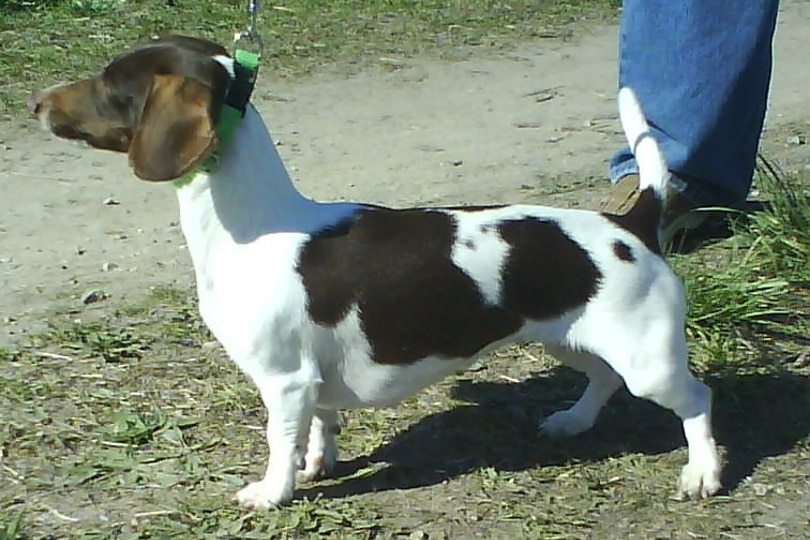Piebald Dachshund: Picture, Guide, Info & More
Updated on

When most people picture the Dachshund in their mind’s eye, they see a long, ridiculously short brown dog with a lengthy snout and soulful eyes. One Dachshund has the same body, snout, and eyes with one significant difference; their body is covered in patches and spots.
If you’ve seen a wiener dog that looks this way, you’ve seen a Piebald Dachshund! The only real difference between a Piebald and a traditional Doxie is the pattern on their coat, which can be quite attractive. Read on to learn more about this unique Dachshund type, where they originated, and unique facts about them and their unusual coloring.
The Earliest Records of Piebald Dachshunds in History
Some of the earliest records of a Dachshund being born with a piebald pattern date back to the mid-15th century in Germany. Since breeders and farmers in Germany created the Dachshund breed to hunt badgers, that’s not surprising. Dachshunds, in general, became very popular in Europe in the early part of the 18th century, and there are various reports of Piebald Dachshunds being seen and bred throughout the continent.
The Piebald Dachshund isn’t a different breed or type but simply a Dachshund with a different coat coloring caused by genetics. The gene itself is known as the “Piebald recessive gene.” What’s interesting to note is that even today, you won’t find many Piebald Doxies in the United Kingdom because British Kennel Clubs forbid them. If you see a Piebald Dachshund in England, a Piebald Dachshund enthusiast probably brought it there from the United States.

How the Piebald Dachshund Gained Popularity
Although you don’t see them often at dog shows, the Piebald Dachshund has become very popular in the United States because of its unique and varied coloring. One problem Piebald Doxies face is that the white base coat has been linked to serious health problems. These include congenital deafness, eye problems, and a high rate of skin cancer. For this reason, reputable breeders are hesitant to breed Piebald Doxies. Still, their unique and lovely coat is a big draw, and they continue to gain popularity in the United States today.
Formal Recognition of the Piebald Dachshund
Since the Piebald Dachshund is not a different breed of Dachshund but has a different coloring on its coat, it is recognized as a Dachshund by the AKC. The only restriction the AKC has is that to be called a Piebald Dachshund, a Dachshund must have at least one spot of color on its white (or cream) colored coat. The AKC recognized the Dachshund as a breed in 1885. As we mentioned earlier, the British Kennel Club doesn’t recognize the Piebald Dachshund out of extreme caution for overbreeding.
Top 10 Unique Facts About the Piebald Dachshund
As you might imagine, the Piebald Dachshund and its attractive coat coloring have several other unique features and traits. Below are 11 of those facts for your enjoyment!

1. Their Base Coat Is Always White
While Piebald Dachshunds come in various colors and color patterns, their base coat is always white, cream, or tan. If you see, for example, a white and black Piebald Dachshund, the black color is patches of black on a white base coat. The same goes for cream and black and tan and black.
2. The Only Way To Get a Piebald Dachshund Is To Breed two Piebalds
The Piebald Dachshund results from a gene referred to as the “recessive Piebald gene.” If the sire has it, but the dam doesn’t, or vice versa, you won’t get a Piebald pup. Both must have the gene and pass it on to their puppies.
3. The Piebald Dachshund Is Actually Quite Common
Piebald Dachshunds have been around almost as long as the Dachshund breed, dating back to the 15th century.
4. More White = More Health Problems
One reason breeders are hesitant to breed Piebald Dachshunds is that they never know what the result will be. The problem is that a Dachshund born with a lot of white and less of the secondary color will usually have more health problems, sometimes severe.
5. Piebald Dachshunds Take Over a Litter
No, the pups don’t boss the others around. What we mean is that if you breed two Piebald Dachshunds, the majority of the litter will be Piebald Dachshunds. Considering that the average Dachshund litter is 5 to 8 puppies, that’s a lot of Piebald Dachshunds!
6. All 3 Dachshund Breeds Can Be Piebald
All three of the main Dachshund varieties can have the Piebald recessive gene and thus be Piebald Dachshunds.
7. The AKC Definition of a Piebald Dachshund Is Very Strict
According to the American Kennel Club (AKC), all a Dachshund needs to be a Piebald Dachshund is one dark spot on a white fur base. Also, they need to have a white tip on their tail. All other traits are considered to be equal to a traditional Dachshund.
8. There are 3 Types of Piebald Dachshunds
There are three main types of Piebald Dachshund: the Tuxedo Piebald, the Plated Piebald, and the Extreme Piebald. Breeders worry about the extreme Piebald due to their health problems. There is also the Dapple Dachshund, but they are exceedingly rare.
9. A True Piebald Dachshund Can’t Have Blue Eyes
Due to genetics, a true Piebald Dachshund will never have blue eyes but only dark brown. Unlike some other dogs with the Piebald coloring, Piebald Dachshunds can’t have one blue eye either. They will always be the same color and always be brown. If your Dachshund does have blue eyes, they are more than likely a Dapple Dachshund.
10. A Piebald Dachshund Can’t have a Predominantly White, Cream, or Tan Coat
To be classified as a Piebald Dachshund, the dog in question can’t be primarily white, cream, or tan but must have more of its secondary color. The secondary color doesn’t matter, as long as there’s more of it than the base color.

Does the Piebald Dachshund Make a Good Pet?
The Piebald Dachshund is exactly the same as the Dachshund except for its unique coloring. That means it has the same traits, both good and bad. Does the Piebald Dachshund make a good pet? For most people, very much so! They are very low maintenance and need less than the typical amount of grooming many breeds require.
Piebald Dachshunds can be very active for short bursts and demand that you be active too, so expect to play with them a lot. They can be stubborn and more than a little bit difficult to train, and like most Dachshunds, the Piebald likes to bark a bit too much. Also, if you have toddlers, be aware that Piebald Dachshunds don’t take kindly to being pulled on or roughly played with. If you have the patience and diligence, however, they will make a fine and fun family pet! Plus, they absolutely love to cuddle!
Final Thoughts
Although they aren’t a specific breed, the Piebald Dachshund is a gorgeous offshoot of the Dachshund and can come in various colors and patterns. Piebald Dachshunds have been around since the breed was first seen in the 1500s when Dachshunds were bred in Germany to be hunters and root out badgers. Unfortunately, breeding Piebald Dachshunds is tricky because of the health problems the white in their coat can cause.
Did you enjoy today’s closer look at the Piebald Dachshund and what makes them so unique? We certainly hope you did and that you now know everything you wanted to know about this lovely and lively spin-off of the Dachshund family tree. If you’re looking to adopt a Piebald Doxie, experts suggest checking with your local animal shelter rather than seeking a breeder, as many overbreed them. Best of luck finding a Piebald Dachshund to adopt!
Featured Image Credit: Elena Grigorieva, Shutterstock













